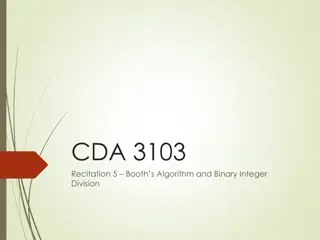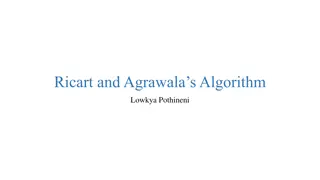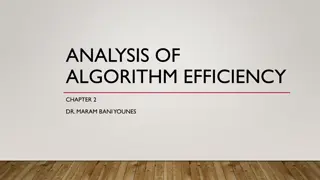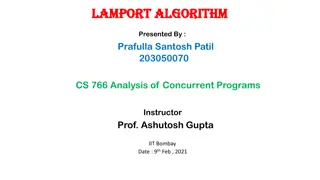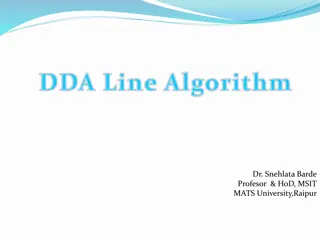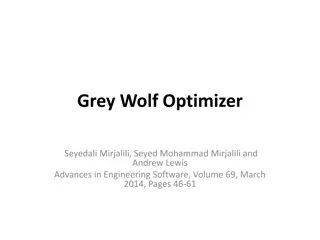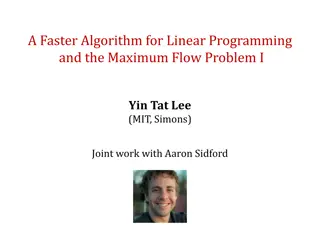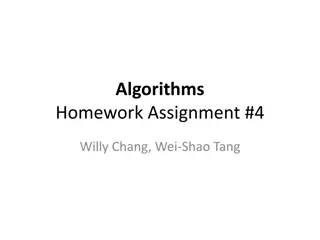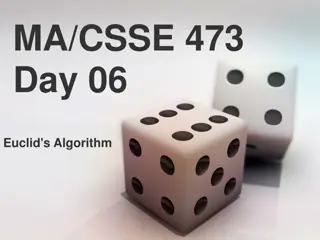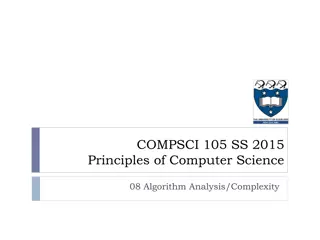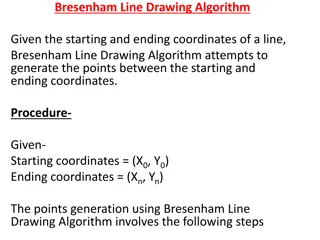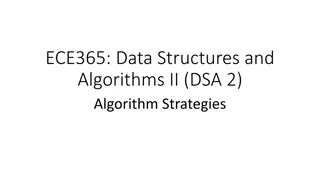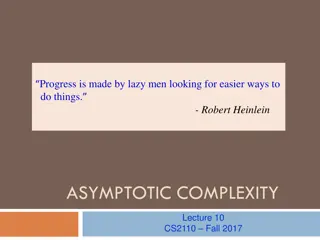Algorithm Efficiency
This content covers various aspects of algorithm efficiency, including different approaches to exponentiation, orders of growth, common growth scenarios, and the impact of algorithmic choices on performance. Learn about constant time algorithms, fast exponentiation methods, linked list operations, and more. Discover how to analyze algorithm efficiency and improve performance through optimization strategies.
Download Presentation

Please find below an Image/Link to download the presentation.
The content on the website is provided AS IS for your information and personal use only. It may not be sold, licensed, or shared on other websites without obtaining consent from the author.If you encounter any issues during the download, it is possible that the publisher has removed the file from their server.
You are allowed to download the files provided on this website for personal or commercial use, subject to the condition that they are used lawfully. All files are the property of their respective owners.
The content on the website is provided AS IS for your information and personal use only. It may not be sold, licensed, or shared on other websites without obtaining consent from the author.
E N D
Presentation Transcript
Exponentiation approach #1 Based on this recursive definition: ?? ? = 0 ?? ?????? 1 ??= ? ?? 1 def exp(b, n): if n == 0: return 1 else: return b * exp(b, n-1) How many calls required to calculate exp(2,16)? Can we do better?
Exponentiation approach #2 Based on this recursive definition: 1 1 2?)2 ?? ? = 0 ?? ? ?? ???? ?? ? ?? ??? ??= (? ? ?(? 1) square = lambda x: x * x def exp_fast(b, n): if n == 0: return 1 elif n % 2 == 0: return square(exp_fast(b, n//2)) else: return b * exp_fast(b, n-1) How many calls required to calculate exp(2,16)? Some algorithms are more efficient than others!
Common orders of growth One way to describe the efficiency of an algorithm according to its order of growth, the effect of increasing the size of input on the number of steps required. Order of growth Description Number of steps increases faster than a polynomial function of the input size. Number of steps increases in proportion to the square of the input size. Number of steps increases in direct proportion to the input size. Number of steps increases proportionally to the logarithm of the input size. Always takes same number of steps, regardless of input size. Exponential growth Quadratic growth Linear growth Logarithmic growth Constant growth
Adding to the front of linked list def insert_front(linked_list, new_val): """Inserts NEW_VAL in front of LINKED_LIST,returning new linked list. >>> ll = Link(1, Link(3, Link(5))) >>> insert_front(ll, 0) Link(0, Link(1, Link(3, Link(5)))) """ return Link(new_val, linked_list) How many operations will this require for increasing lengths of the list? List Size Operations 1 10 100 1000 1 1 1 1
Constant Time An algorithm that takes constant time, always makes a fixed number of operations regardless of the input size. List Size 1 10 100 1000 Operations 1 1 1 1
Fast Exponentiation square = lambda x: x * x def exp_fast(b, n): if n == 0: return 1 elif n % 2 == 0: return square(exp_fast(b, n//2)) else: return b * exp_fast(b, n-1) How many operations will this require for increasing values of n? N 0 8 16 1024 Operations 1 5 6 12
Logarithmic Time When an algorithm takes logarithmic time, the time that it takes increases proportionally to the logarithm of the input size. N 0 8 16 1024 Operations 1 5 6 12
Finding values in a linked list def find_in_link(ll, value): """Return true if linked list LL contains VALUE. >>> find_in_link(Link(3, Link(4, Link(5))), 4) True >>> find_in_link(Link(3, Link(4, Link(5))), 7) False """ if ll is Link.empty: return False elif ll.first == value: return True return find_in_link(ll.rest, value) How many operations will this require for finding a value in the list? Consider both the best case and worst case. List Size Best case: Operations 0 10 100 1000 1 Worst Case: Operations 1 10 100 1000 1 1 1
Linear Time When an algorithm takes linear time, its number of operations increases in direct proportion to the input size. List Size Worst Case: Operations 1 1 10 10 100 100 1000 1000
Counting overlapping items in lists def overlap(a, b): """ >>> overlap([3, 5, 7, 6], [4, 5, 6, 5]) 3 """ count = 0 for item in a: for other in b: if item == other: count += 1 return count 3 5 6 7 4 5 + 6 + 5 + How many operations will this require for finding the overlapping elements? List Size Operations 1 10 100 1000 1000000 1 100 10000
Quadratic Time When an algorithm grows in quadratic time, its steps increase in proportion to square of the input size. List Size Operations 1 1 10 100 100 10000 1000 1000000
Recursive Virahanka-Fibonacci def virfib(n): if n == 0: return 0 elif n == 1: return 1 else: return virfib(n-2) + virfib(n-1) How many operations are required for increasing values of n? N 1 2 3 4 7 8 20 Operations 1 3 5 9 41 67 21891
Exponential Time When an algorithm grows in exponential time, its number of steps increases faster than a polynomial function of the input size. N 1 2 3 4 7 8 20 Operations 1 3 5 9 41 67 21891
Big O Notation A formal notation for describing the efficiency of an algorithm, using asymptotic analysis. Order of growth Example Big O Exponential growth recursive virfib O(bn) Quadratic growth overlap O(n2) Linear growth find_in_link O(n) Logarithmic growth exp_fast O(log n) Constant growth add_to_front O(1)
Space and environments The space needed for a program depends on the environments in use. At any moment there is a set of active environments. Values and frames in active environments consume memory. Memory that is used for other values and frames can be recycled. Active environments: Environments for any function calls currently being evaluated. Parent environments of functions named in active environments.
Active environments in PythonTutor def virfib(n): if n == 0: return 0 elif n == 1: return 1 else: return virfib(n-2) + virfib(n-1) View in PythonTutor Make sure to select "don't display exited functions"
Visualization of space consumption virfib(5) ret: 5 virfib(3) ret: 2 virfib(4) ret: 3 virfib(1) ret: 1 virfib(2) ret: 1 virfib(2) ret: 1 virfib(3) ret: 2 virfib(0) ret: 0 virfib(1) ret: 1 virfib(0) ret: 0 virfib(1) ret: 1 virfib(1) ret: 1 virfib(2) ret: 1 virfib(0) ret: 0 virfib(1) ret: 1
Memoization Memoization, or caching, is a strategy to reduce redundant computation by remembering the results of previous function calls in a "memo" or cache.
A memoization HOF def memo(f): cache = {} def memoized(n): if n not in cache: cache[n] = f(n) return cache[n] return memoized
Memoizing Virahanka-Fibonacci n 5 Original 15 Memoized 9 6 25 11 7 41 13 8 67 15 10 177 19 20 21891 39 Video visualization



